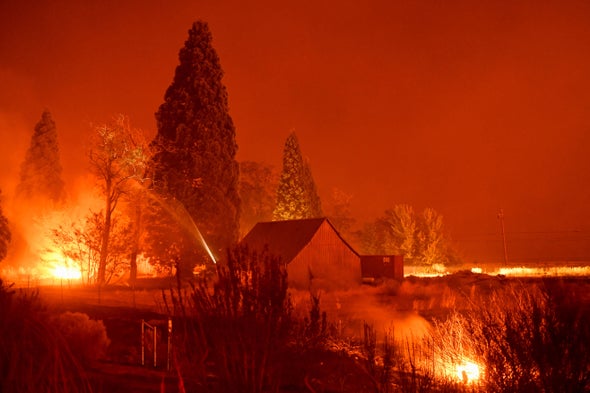CLIMATEWIRE | More than a half-million Americans had close encounters with catastrophic wildfires between 2000 and 2019 — partly because they lived in high-risk wildfire areas, but also because fires are growing larger and encroaching on areas once deemed lower-risk, research shows.
Those findings, published in the journal Nature Sustainability, reflect what experts from Boise State University call “cumulative primary human exposure” to wildfire. It is a sobering indicator of how wildfires are shifting closer to populated areas, a condition that will worsen as the planet warms.
“This is wildfire getting out of hand,” said Mojtaba Sadegh, an assistant professor of civil engineering at Boise State and senior author of the study published this month. “In many cases, the populations were already there, but climate [conditions] were not ripe for frequent wildfires. Now they are.”
More than 8 in 10 people in the highest-risk areas — those within a “wildfire perimeter” — lived in Western states, notably California, the researchers found. But more than 106,000, or 18 percent, of those facing catastrophic risk were in states from the Great Plains to Florida.
“Our results highlight that deliberate mitigation and adaptation efforts to help societies cope with wildfires are ever more needed,” the study stated.
Researchers examined data from more than 15,000 wildfires across the lower 48 states between 2000 and 2019, then used population distribution data to estimate how many people were exposed to those fires. Findings show that primary population exposure to wildfire increased 125 percent in the continental United States over those 20 years.
Researchers cautioned that there were “large statistical uncertainties” in the trend analysis due to the study's relatively short timeline, but Sadegh said it is clear wildfires are rising in intensity and frequency due to climate change.
Data modeling and analysis from independent groups such as the First Street Foundation have drawn similar conclusions about expanding wildfire risk.
While significant attention has been paid to the encroachment of houses into fire-prone areas, the researchers found that an "increased wildfire extent drove the majority of the observed trends.”
In fact, only 24 percent of those facing the highest wildfire risk between 2000 and 2019 moved into a fire-prone region, according to the Boise State study. Seventy-six percent were already living in what they thought were reasonably safe communities. “These people didn’t realize how dramatically wildfire dynamics would change during their lifetimes,” Sadegh said in an interview.
Beyond the immediate threats to life and property, health experts have warned of the indirect impacts from wildfires, including drinking water contamination, mud and debris flows, and smoke inhalation.
Tens of millions of Americans this summer have seen firsthand how wildfire smoke affects human health. Smoke from Canadian wildfires has blanketed much of the United States in recent weeks, including the East Coast where that kind disaster is uncommon, at least for now.
“The eastern U.S. has not seen the worst of it yet,” Sadegh said. “The projections show that future forest fires in the East are expected to increase [with climate change], and the wildfires there are going to be larger and more intense.”
Fires like those in Canada could become common in forests from Maine to Minnesota as conditions grow warmer and drier, experts say. Northern Minnesota’s Superior National Forest, for example, has seen an marked uptick in wildfires, including a 93,000-acre fire in 2011 in the pristine Boundary Waters Canoe Area Wilderness.
Sadegh said the findings have immediate implications for local, state and federal agencies responsible for maintaining firefighting infrastructure and human resources, as well as managing wildfire evacuations. Insurers, too, are becoming more aware of wildfire risk, particularly in places such as California, resulting in rising premiums and even policy cancellations.
"This is something we need to live with; this is not going to go away, especially in the next couple of decades,” he said. “We have to think about how we become more resilient to this.”
Reprinted from E&E News with permission from POLITICO, LLC. Copyright 2023. E&E News provides essential news for energy and environment professionals.


